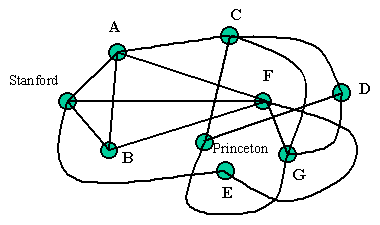
Problem 1
One of the original design goals of ARPANET, the precursor
of the Internet, was that it should be fault-tolerant and
able to survive incidents
that destroyed parts of it. In that spirit, here is a
fake network with routers (the circles) and links between them
(the lines):

(a) What is the smallest set of links that you would have to destroy to disconnect "Princeton" from "Stanford"? List the links by their endpoints, for example A-B or Stanford-F.
(b) If a router is destroyed, any link connected to it no longer works. What is the smallest set of routers that you would have to destroy to disconnect "Princeton" from "Stanford" (not including Stanford or Princeton themselves)? List the routers by letter.
(c) What routers are two "hops" away from Princeton? That is, what routers can you reach from Princeton by going through exactly two links?
(d) What is the shortest path (that is, the path with the fewest links) from Princeton to Stanford? Give the list of routers that make up the path.
(e) What is the longest path from Princeton to Stanford that doesn't have a loop, that is, that doesn't go through any router more than once?
Problem 2
For many years now, the number of computers on the Internet has roughly
doubled every year. Will this trend keep on going forever, or will it
eventually stop? If you think it will go on forever, explain why. If you
think it will stop, give a guesstimate of when it will stop and why.
(Assume that there are about 100 million computers on the Internet now.)
Problem 3
The University's library contains about five million books. Assume that
each book contains about ten million bits of information.
(a) How many total bits of information does the library contain?
(b) How long would it take to download the entire contents of the library over a modem connection running at 50,000 bits per second?
(c) How long would it take to download the entire contents of the library over a Dormnet connection running at 10,000,000 bits per second?
(d) How long would it take to download the entire contents of the library over a "gigabit ethernet" connection at 1,000,000,000 bits per second?
Problem 4
Consider your answer to problem 3d, under the assumption that everybody will
have a gigabit ethernet connection to their home in a few years. How do
you think this affects the future of libraries and librarians?